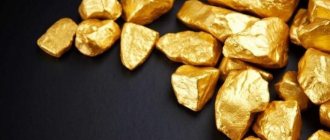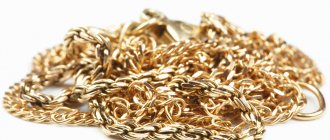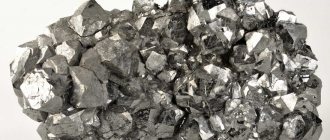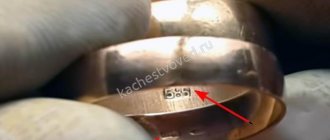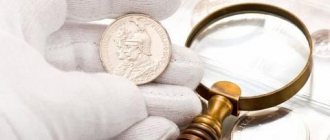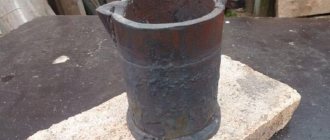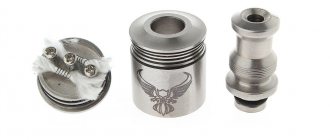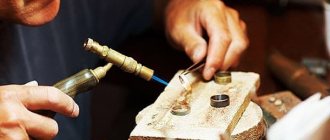Hello, dear gold lovers! Many people admire its pleasant shine, although not everyone knows that it is due to the structure of its energy levels and the highest number of electrons among metals. Every woman wants to feel the pleasant weight of a massive precious necklace on her neck, not realizing that the reason for the large weight of gold jewelry is the high density of gold. Read this article - and you can easily figure out what this value means and what practical significance it has.
Properties and composition of gold
It was the properties of gold that determined this metal to be noble. The main chemical property of a precious metal for us is its inertness - in our usual environment, it remains unchanged for thousands of years, without oxidizing or losing its appearance.
Basic physical properties of Au:
- softness;
- ductility;
- plastic;
- low resistance;
- high thermal conductivity;
- high density.
These qualities are what made the yellow metal so valuable.
The composition of 999.9 fine gold is pure Aurum, its density is 19.30 grams per cubic centimeter or 19,300 kg per m³.
It is known that, due to its softness and high specific gravity, products made from high-grade gold are impractical, so jewelers use the precious metal in their products only in an alloy with others - to give strength or a different shade. Thus, the traditional 585 standard contains, in addition to gold, copper and silver.
Density of gold depending on the sample
In terms of density, the yellow metal is surpassed only by platinum. All other metals in the alloy reduce the overall density of the product.
This table clearly shows the correlation between density and ligature.
| Try | Color | Compound | Density g/m³ |
| 750 | Yellow | Au, Ag, copper Au, Ag Au, Ag, palladium Au, Ag, nickel, zinc | 15,45 15,96 16,44 15,38 |
| Green | |||
| White | |||
| White | |||
| 585 | Red | Au, Ag, copper Au, Ag, copper Au, Ag, copper Au, Ag, palladium Au, Ag, nickel, zinc, copper | 13,24 13,60 13,92 14,74 12,85 |
| Yellow | |||
| Green | |||
| White | |||
| White | |||
| 375 | Red | Au, Ag, copper | 11,54 |
| 375 | Pink | Au, Ag, palladium, copper | 11,56 |
How does temperature affect density?
It is interesting that the indicated values are typical only for normal environmental conditions and a temperature of 20 ° C. The higher the temperature, the lower the density, and vice versa. This dependence is typical for most substances, except water, whose density is maximum at +4, and decreases with decreasing temperature.
Determination of carat weight
British carats are a traditional value used to measure the purity of gold and its weight in a product. The smallest value is 8 carats (K). The specific gravity of 999 gold is 24 carats. If other elements are added to the alloy to change the characteristics of the metal, the carat value drops. The 18-karat precious metal contains 6 parts of impurities and 18 parts of pure gold.
For example, high-grade 917 gold has a mass of 22 carats. And such a popular 585 alloy is only 14 carats.
How to distinguish real yellow metal from a fake
Understanding the essence of density as a physical quantity will help us distinguish real gold from counterfeit gold. I'll tell you how to do this.
Au has virtually the highest density of any precious metal other than platinum, meaning that almost any gold item will weigh more than a gram.
The easiest way is to weigh the jewelry. The method is suitable for small openwork decorations.
Massive rings and chains, bracelets and earrings are checked based on the ratio of mass to volume.
We will need:
- precision scales with division values down to a hundredth of a gram;
- beaker with volume graduation. The narrower it is, the higher the accuracy of the determined value. It can be purchased at chemical stores and sometimes in pharmacies.
For clarity, I will try to determine the authenticity (maybe the purity) of my rose gold bracelet:
- I weigh the bracelet on the scales. It weighs 4.62 grams.
- I pour water into a beaker and put the bracelet in it. The water should completely cover the decoration. The bracelet displaced 0.4 centimeters of cubic water. That is, I have a beaker with a CD of 0.1 cm3, the water level has risen by 4 divisions.
- I make the calculation: 4.62/0.4=11.55.
- I compare the obtained value with the table of metal densities and the table of Au density (depending on the sample).
Palladium is close to the obtained values - 12.2, lead - 11.34, silver - 10.49. But my bracelet is a nice shade of pink, which means it most likely contains gold and copper. From the table we see that the density of my bracelet corresponds to 375 samples - the average value of gold, silver, palladium and copper.
The amount of pure element in the alloy is determined using the molar mass of gold using the formula M = m/n. The molar mass of Au is 196.9665 g/mol. In my bracelet weighing 4.62 g and 375 samples, there is 4.63 * 0.375 = 1.74 g of gold, 1.74 g / 196.9665 g / mol = 0.001 mol of pure gold.
Gemini of gold
It happens that unscrupulous jewelers, knowing that the density of the yellow metal or its alloys is close in value to base metals, use this value for criminal purposes. Thus, lead with gold plating can easily pass for 375 standard, and tungsten, which has a molar mass close to platinum group metals, is often passed off by jewelers as precious metals.
Graphite grades
It is possible to synthesize material with different grain sizes:
- 500–3000 microns – coarse-grained graphite, grade EG, GE;
- 150–500 microns – medium-grained, grades PPG, VPG, V-1;
- 30–50 microns – fine-grained, grades MPG, MG, ARV;
- 30–150 microns – fine-grained isotropic, grade MIG-1;
- 1–30 microns – fine-grained, MIG-2 grade and isostatic graphites.
Artificial graphite is widely used in all industries. For example, electrodes are made from coarse-grained material. Fine-grained structural graphite of the ARV and MG grades is used in the manufacture of shaped products of complex shapes. The use of artificial graphite allows us to achieve the highest precision in the manufacture of various parts and produce equipment that meets the standards of the 21st century.
Characteristics of individual alloys
The density of a material is a physical property that is determined by the mass of a certain unit of volume. The measurement of the parameter is determined by the ratio of the mass and size of the body.
An alloy of gold with other metals is indicated by a breakdown, which is applied directly to the product.
Rare samples
The highest and rarest standard is 999. It cannot be found on jewelry. This means pure precious metal that is not used for production. The density of 999 gold is 19.3 grams per cubic centimeter.
Slightly more than 96% of pure gold is contained in products marked 958. However, they are extremely rare due to the fragility of the metal and the impossibility of polishing it. The density of this material is 18.3 g/cm3.
900 and 917 samples are rare in Russia. High-quality jewelry is made only to order. Previously, coins were minted from gold metal of the highest standard , which is why the samples are called coin samples. The composition of gold in them is 90%. The alloy contains silver and copper in prescribed proportions. Density indicators for such alloys vary from 17.3 to 17.9 grams per cubic centimeter.
75.5% of the precious metal is contained in products of 750 standard. Additionally, palladium, copper, platinum, silver, and nickel are introduced into the alloy. A fairly durable metal that can be processed, polished and has good strength characteristics. The density of 750 gold varies from 14.4 to 17.4 grams per cubic centimeter.
Most Popular
585 standard (583 in the Soviet Union) contains more than 58% pure yellow metal. The main components of the alloy are silver, nickel, palladium and copper. This is the most popular alloy in jewelry. It is durable, hard, and easy to work with. Most of the jewelry is made from 585 alloy. Its average density is 13 g/cm3.
Products marked 500 contain 50.5% gold. The remaining 49.5% is made up of copper and silver, and not in equal proportions, so the color of the product directly depends on the amount of silver in the alloy. The density of the alloy is 12.3 g per cubic centimeter.
375 standard is considered the cheapest. It contains 38% pure yellow precious metal, the rest is occupied by copper and silver. Low-grade gold tends to deteriorate in appearance when exposed to oxygen and tarnishes over time. The density of the alloy is 11.5 g/cm3.
As a rule, the alloy contains only elements that have a similar specific gravity and density to gold. However, there is a danger of getting a fake instead of gold jewelry. Most often, tungsten is disguised as a yellow precious metal. It has similar performance and appearance. It is extremely difficult to distinguish a fake from the original.
Don't try it on your teeth!
Gold is a soft metal, so if you squeeze it hard with your teeth, marks will appear. Agree, the seller will not like it and will force you to buy.
Athletes test their medals for the sake of photos. Moreover, gold medals are actually just gold plated.
By the way, fake aluminum behaves exactly the same way, so if the seller insists on a “teeth test”, don’t be fooled.
On the other hand, only a new product does not have even small scratches on the surface. If a person claims to be selling his used gold, but it appears to have only come from a factory, something is wrong here.
Hydrostatic testing of jewelry
You can identify a fake piece of jewelry by its density.
You can do this in the following way:
| 1) Place the product on the scale, write down the dry weight (m) | |
| 2) Place a plastic transparent cup on the scale, 2/3 filled with water, reset the scale readings to zero | |
| 3) Immerse the product suspended on a thread into water so that it does not touch the walls and bottom, but so that it is completely immersed in water, write down the scale readings (v) |
Next is a simple calculation using the formula p=m/v and determination of the sample using the indicators from the table.
Ring weight dry (m) = 28g, weight in water (v) = 3.12g, 28:3.12=8.97
Judging by this value, it is clear that this is not gold.
The densities of the most popular samples are given below:
Please note that this method will not work for hollow items or items that have a large number of inserts.
Video on checking jewelry using the hydrostatic method.
Newsletter for pawnshop managers
Source
Attach a magnet
Plating steel or other alloys with a high iron content with gold or its imitation is a common practice. Only ferromagnets are strongly magnetic - iron, cobalt, nickel, gadolinium, terbium, dysprosium, holmium, erbium, thulium.
Dimagnets (for example, water or table salt) and paramagnets (aluminum, etc.) are weakly magnetic. All non-ferrous metal is not magnetic.
If it happens on the beach or in places where tourists gather, buy the cheapest magnet in a souvenir shop and attach it to the product. If it sticks, it’s definitely a fake or the metal is of too low standard (too many iron impurities). If not, perform other checks.
Invest today
The algorithm of actions is as follows:
We calculate the density of gold using the formula:
P = m / V = 5.77 / 0.5 = 11.54 g/cm3
The resulting value corresponds to the value for the 375 red gold alloy.
But unfortunately, the experiment cannot 100% confirm that precious metal was used to make the chain.
Draw with lapis pencil
A lapis pencil is needed to stop the bleeding. This is an antiseptic based on silver nitrate, it can be bought at a pharmacy, it costs about 100-150 rubles.
To check the authenticity of gold, soak the item in water. Then, using a lapis pencil, draw a small line over the wet one and wipe it off.
Lapis does not react with gold, but does react with other metals. If a trace remains, then the gold is fake or of very low standard. Nothing will happen to genuine metal.
Test with black bread
The method is safe (for real gold!), but slow. Take the crumb of black bread, remember, mix with water and stick the mixture onto the product. Leave it until the bread crumb turns into a dry crust, then break it apart.
If there are dark traces inside the crumb, it means the fake has oxidized. If not, then it is either gold or good gilding.
Test with vinegar
Tell the seller that you will test the gold with vinegar. Are you nervous? There’s no need to run to the grocery store anymore. But a professional who is confident in his product will not sweat it.
Fake gold quickly darkens in vinegar - just pour a little into a glass and hold the metal in it for about five minutes. But real high-grade metal doesn’t care about anything.
Drop some iodine
Rub the product on jeans or other thick fabric, then drop iodine on this place on the metal. High standard gold does not darken. If the metal has darkened (this may appear within a minute), the product is not genuine or the standard is not too high.
But brass and copper do not change color from iodine either. So this testing method is good for high-grade gold, but it is not enough on its own.
We do not recommend testing products with iodine levels of 585 or lower. After iodine, you will definitely have to polish them or remove stains with ammonia; traces may remain.
